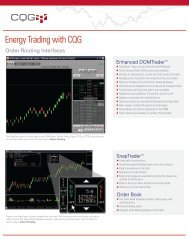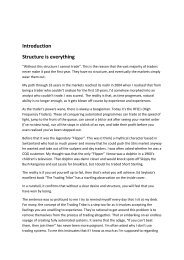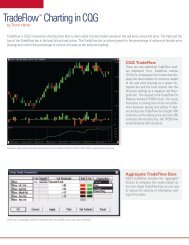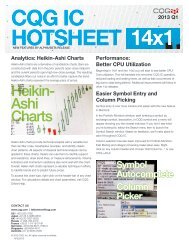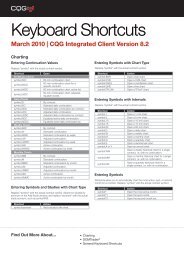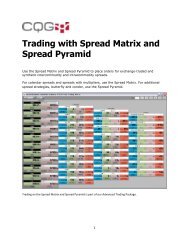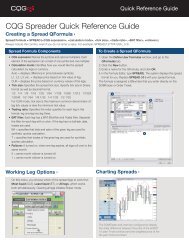Trading Time. - CQG.com
Trading Time. - CQG.com
Trading Time. - CQG.com
Create successful ePaper yourself
Turn your PDF publications into a flip-book with our unique Google optimized e-Paper software.
those days there was also a T Bond contract on LIFFE, and theories that developed<br />
between the differences in London’s morning and Chicago’s opening ended up<br />
transferring their logic to the current overnight session and the regular trading hours. The<br />
conclusions I came to became my road map to short-term movement and this has<br />
developed over the years. The study that can now be found on <strong>CQG</strong> has greatly<br />
simplified matters.<br />
Market Profile® remains my first port of call, whatever asset class or instrument I’m<br />
trading. The theories now extend to methods of scalping, day trading, structured plays,<br />
providing targets, placement of stops, the strength of the trend and optimum points for<br />
where corrections should begin and trends should end. Once the structure has been<br />
understood, the trader can switch their focus to the other studies used in their technical<br />
framework. It can often be the case that, by the time the main strategic trade concludes,<br />
the short-term trades working the core position have made more than if the actual<br />
strategic position was simply left alone from entry to eventual exit. Understanding the<br />
short-term bias when it’s in the opposite direction to the core trade allows the overall<br />
entry point to change to a more advantageous position. For the aggressive, it can<br />
highlight moments when the existing core trade can be pyramided for a day trade, via<br />
Market Profile® techniques, divergence patterns, true measurements of overbought and<br />
oversold, and/or the <strong>Time</strong>-based studies in the previous chapter.<br />
Whilst the ability to shift between short and long-term focus requires practice, discipline<br />
and skill, once mastered it provides the structure to actively manage positions. The full<br />
range of trading techniques are beyond the scope of this book as the concentration is on<br />
time with an emphasis on the short-term movement, although it does touch on the longterm<br />
distribution techniques that are a core element in defining major supports and<br />
resistances. Even so, the section that follows still provides an in-depth guide to some of<br />
the timing techniques. Dedication and effort are required to master the concepts and be<br />
able to trade with great confidence. The majority of the theories apply to most markets<br />
and asset classes but where there are differences they have been flagged.<br />
Briefly, the connection between long-term profiles and the shortterm<br />
<strong>Time</strong> based movements enables low-risk entries with tight<br />
stops. The mantra “the chart tells you don’t tell the chart” means, however, that the<br />
risk/reward ratio cannot be calculated but the exit point is certain.




